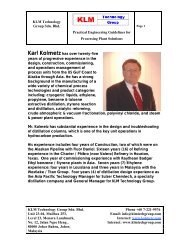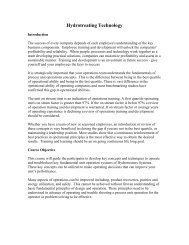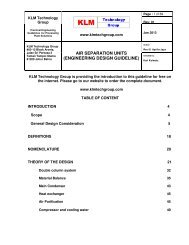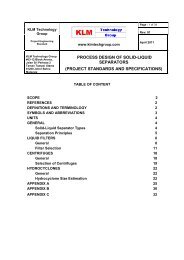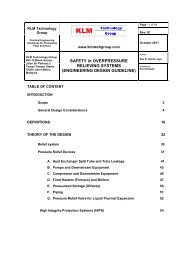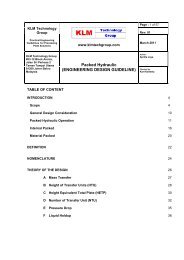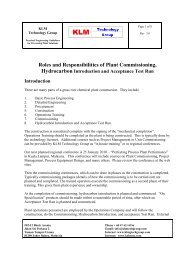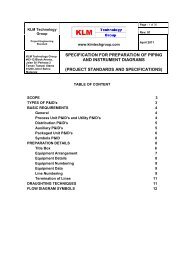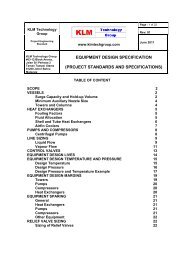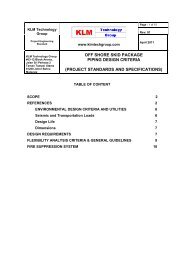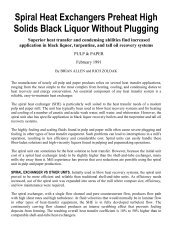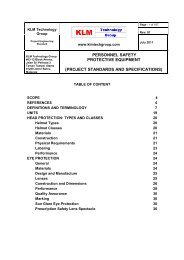coalescer (engineering design guideline) - KLM Technology Group
coalescer (engineering design guideline) - KLM Technology Group
coalescer (engineering design guideline) - KLM Technology Group
Create successful ePaper yourself
Turn your PDF publications into a flip-book with our unique Google optimized e-Paper software.
<strong>KLM</strong> <strong>Technology</strong><strong>Group</strong>Page : 1 of 49Rev: 01Practical EngineeringGuidelines for ProcessingPlant Solutionswww.klmtechgroup.comOct 2012<strong>KLM</strong> <strong>Technology</strong> <strong>Group</strong>#03-12 Block Aronia,Jalan Sri Perkasa 2Taman Tampoi Utama81200 Johor BahruCOALESCER(ENGINEERING DESIGN GUIDELINE)Author:Rev 01 Aprilia JayaKarl Kolmetz<strong>KLM</strong> <strong>Technology</strong> <strong>Group</strong> is providing the introduction to this <strong>guideline</strong> for free onthe internet. Please go to our website to order the complete document.www.klmtechgroup.comTABLE OF CONTENTINTRODUCTION 4Scope 4General Design Consideration 5DEFINITIONS 23NOMENCLATURE 25THEORY OF THE DESIGNLiquid-Liquid Coalescer Design 27A. Stokes Settling 27B. Direct Interception 31Liquid-Gas Coalescer Design 33A. Gravity Settling 34B. Media Velocity 37
<strong>KLM</strong> <strong>Technology</strong><strong>Group</strong>Practical EngineeringGuidelines for Processing PlantSolutionsCOALESCER(ENGINEERING DESIGN GUIDELINES)Page 2 of 49Rev: 01Oct 2012C. Annular Velocity 37APPLICATIONExample 1: Liquid-Gas Horizontal Coalescer Design 42Example 2: Liquid-Gas Vertical Coalescer Design 44Example 3: Liquid-Liquid Coalescer Design 46REFEREENCES 48CALCULATION SPREADSHEETLiquid-Gas Horizontal Coalescer Design.xls 49Liquid-Gas Vertical Coalescer Design.xls 50Liquid-Liquid Coalescer Design.xls 51LIST OF TABLETable 1. Coalescing media 12Table 2. Coalescing media and their applications 13Table 3: Typical sources and characteristics that can generate dispersion 30Table 4: Type of coalesce with their coefficient 32LIST OF FIGUREFigure 1: Vertical coalesce 6Figure 2: Horizontal coalesce 7Figure 3: Three steps coalescing 9These <strong>design</strong> <strong>guideline</strong> are believed to be as accurate as possible, but are very general and not for specific <strong>design</strong>cases. They were <strong>design</strong>ed for engineers to do preliminary <strong>design</strong>s and process specification sheets. The final<strong>design</strong> must always be guaranteed for the service selected by the manufacturing vendor, but these <strong>guideline</strong>s willgreatly reduce the amount of up front <strong>engineering</strong> hours that are required to develop the final <strong>design</strong>. The <strong>guideline</strong>sare a training tool for young engineers or a resource for engineers with experience.This document is entrusted to the recipient personally, but the copyright remains with us. It must not be copied,reproduced or in any way communicated or made accessible to third parties without our written consent.
<strong>KLM</strong> <strong>Technology</strong><strong>Group</strong>Practical EngineeringGuidelines for Processing PlantSolutionsCOALESCER(ENGINEERING DESIGN GUIDELINES)Page 3 of 49Rev: 01Oct 2012Figure 4: Zones where different coalescing mechanisms apply 10Figure 5: Coalescing in the medium 14Figure 6: Horizontal liquid–liquid <strong>coalescer</strong> configuration 17Figure 7: Vertical liquid–liquid <strong>coalescer</strong> configuration 18Figure 8: High efficiency liquid-gas coalesce 22Figure 9: Forces on a light droplet dispersed in a heavy liquid 28Figure 10: Mechanism in liquid-gas coalesce 34Figure 11: Forces on Liquid Droplet in Gas Stream 35Figure 12: Drag coefficient of rigid sphere 36Figure 13: Effect of surface treatment on annular velocity (a) surface treated and (b)untreated 40These <strong>design</strong> <strong>guideline</strong> are believed to be as accurate as possible, but are very general and not for specific <strong>design</strong>cases. They were <strong>design</strong>ed for engineers to do preliminary <strong>design</strong>s and process specification sheets. The final<strong>design</strong> must always be guaranteed for the service selected by the manufacturing vendor, but these <strong>guideline</strong>s willgreatly reduce the amount of up front <strong>engineering</strong> hours that are required to develop the final <strong>design</strong>. The <strong>guideline</strong>sare a training tool for young engineers or a resource for engineers with experience.This document is entrusted to the recipient personally, but the copyright remains with us. It must not be copied,reproduced or in any way communicated or made accessible to third parties without our written consent.
<strong>KLM</strong> <strong>Technology</strong><strong>Group</strong>Practical EngineeringGuidelines for Processing PlantSolutionsCOALESCER(ENGINEERING DESIGN GUIDELINES)Page 4 of 49Rev: 01Oct 2012<strong>KLM</strong> <strong>Technology</strong> <strong>Group</strong> is providing the introduction to this <strong>guideline</strong> for free onthe internet. Please go to our website to order the complete document.INTRODUCTIONScopewww.klmtechgroup.comThis <strong>guideline</strong> covers the basic elements of <strong>coalescer</strong> <strong>design</strong> in sufficient detail to allowan engineer to <strong>design</strong> a <strong>coalescer</strong> with the suitable size including diameter, lengthmedia velocity, and terminal settling velocity.For <strong>coalescer</strong>s, as with any process equipment, successful sizing and selection isalways a combination of empirical observation/experience and analytical modeling. Ofthe three steps in coalescing – droplet capture, combining of the collected droplets, andgravity separation of the enlarged droplets – the first and the last can be modeled withgood accuracy and repeatability. The modeling of the middle and the actual coalescingstep is a complex function of surface tension and viscous effects, droplet momentum,and the dynamics of the sizes of the droplets in the dispersion.The <strong>design</strong> of <strong>coalescer</strong> may be influenced by factors, including process requirements,economics and safety. In this <strong>guideline</strong> there are tables that assist in making thesefactored calculations from the various reference sources. Include in this <strong>guideline</strong> is acalculation spreadsheet for the <strong>engineering</strong> <strong>design</strong>. .All the important parameters use inthe <strong>guideline</strong> are explained in the definition section which helps understand the meaningof the parameters or the terms used.The theory section explains source, type of coalesces and its characteristic of droplet,treated and untreated <strong>coalescer</strong> and how to calculate sizing and selecting the<strong>coalescer</strong>. The application of the <strong>coalescer</strong> theory with an example will help theengineer understand the <strong>coalescer</strong> and the ready to perform the actual <strong>design</strong> of the<strong>coalescer</strong>.These <strong>design</strong> <strong>guideline</strong> are believed to be as accurate as possible, but are very general and not for specific <strong>design</strong>cases. They were <strong>design</strong>ed for engineers to do preliminary <strong>design</strong>s and process specification sheets. The final<strong>design</strong> must always be guaranteed for the service selected by the manufacturing vendor, but these <strong>guideline</strong>s willgreatly reduce the amount of up front <strong>engineering</strong> hours that are required to develop the final <strong>design</strong>. The <strong>guideline</strong>sare a training tool for young engineers or a resource for engineers with experience.This document is entrusted to the recipient personally, but the copyright remains with us. It must not be copied,reproduced or in any way communicated or made accessible to third parties without our written consent.
<strong>KLM</strong> <strong>Technology</strong><strong>Group</strong>Practical EngineeringGuidelines for Processing PlantSolutionsCOALESCER(ENGINEERING DESIGN GUIDELINES)Page 5 of 49Rev: 01Oct 2012General Design ConsiderationThe biggest development in recent years is the widespread recognition that the actualperformance of a separator may fall far short of the theoretical performance due to theactual flow patterns within the vessel being far from the ideal. It has, however beenhelped by two visualization techniques computational fluid dynamics (CFD) and physicalmodeling, which vividly show what can go wrong and how to correct it.The following factors must be determined before beginning separator <strong>design</strong>.1. Gas and liquids flow rates (minimum, average, and peak).2. Operating and <strong>design</strong> pressures and temperatures.3. Surging or slugging tendencies of the feed streams.4. Physical properties of the fluids, such as density, viscosity, and compressibility.5. Designed degree of separationThe most important areas to ensure a separator performs to <strong>design</strong> are as follow.1. Correct inlet nozzle sizing and a good inlet device (momentum breaker).2. Primary fluid distribution–distribution plates to translate the reduced but still highvelocities from the inlet device into quiescent flows in a liquid–liquid separator body,or distribution plates either side of a vane pack (downstream is best as upstreamones shatter droplets unnecessarily) or other gas demister.3. Intermediate fluid distribution when necessary.4. Exit devices: vortex breakers and anti-liquid–pickup details.Coalescer is a mechanical process vessel with wettable, high-surface area packing onwhich liquid droplets consolidate for gravity separation from a second phase (forexample gas or immiscible liquid), where small particles of one liquid phase must beseparated or removed from a large quantity of another liquid phase. The <strong>coalescer</strong>smight be <strong>design</strong>ed vertically or horizontally.The vertical <strong>design</strong> is used to separate water from hydrocarbons when the interfacialtension is greater than 3 dyne/cm. The separation stage is achieved using hydrophobicseparator cartridges that provide an effective barrier to aqueous coalesced drops, butThese <strong>design</strong> <strong>guideline</strong> are believed to be as accurate as possible, but are very general and not for specific <strong>design</strong>cases. They were <strong>design</strong>ed for engineers to do preliminary <strong>design</strong>s and process specification sheets. The final<strong>design</strong> must always be guaranteed for the service selected by the manufacturing vendor, but these <strong>guideline</strong>s willgreatly reduce the amount of up front <strong>engineering</strong> hours that are required to develop the final <strong>design</strong>. The <strong>guideline</strong>sare a training tool for young engineers or a resource for engineers with experience.This document is entrusted to the recipient personally, but the copyright remains with us. It must not be copied,reproduced or in any way communicated or made accessible to third parties without our written consent.
<strong>KLM</strong> <strong>Technology</strong><strong>Group</strong>Practical EngineeringGuidelines for Processing PlantSolutionsCOALESCER(ENGINEERING DESIGN GUIDELINES)Page 6 of 49Rev: 01Oct 2012allow hydrocarbon to pass through them. The separator cartridges can be stackedbelow the <strong>coalescer</strong>s for the most efficient utilization of the separator medium. Thisconfiguration only applies to the separation of water or aqueous contaminants fromhydrocarbons.After leaving the coalescing stage, the large aqueous coalesced drops and hydrocarbonthen flow axially in a downward direction and the flow direction is from the outside of theseparator to the inside. The large coalesced drops are repelled by the separators andare collected in the bottom sump. The purified hydrocarbon passes through theseparators and exits at the bottom of the housing. The aqueous phase in the collectionsump can be drained manually on a periodic basis or equipped with an automatic levelcontrol and drain system.Figure 1: Vertical <strong>coalescer</strong>These <strong>design</strong> <strong>guideline</strong> are believed to be as accurate as possible, but are very general and not for specific <strong>design</strong>cases. They were <strong>design</strong>ed for engineers to do preliminary <strong>design</strong>s and process specification sheets. The final<strong>design</strong> must always be guaranteed for the service selected by the manufacturing vendor, but these <strong>guideline</strong>s willgreatly reduce the amount of up front <strong>engineering</strong> hours that are required to develop the final <strong>design</strong>. The <strong>guideline</strong>sare a training tool for young engineers or a resource for engineers with experience.This document is entrusted to the recipient personally, but the copyright remains with us. It must not be copied,reproduced or in any way communicated or made accessible to third parties without our written consent.
<strong>KLM</strong> <strong>Technology</strong><strong>Group</strong>Practical EngineeringGuidelines for Processing PlantSolutionsCOALESCER(ENGINEERING DESIGN GUIDELINES)Page 7 of 49Rev: 01Oct 2012In the horizontal configuration, a settling zone achieves separation by gravity. Thisconfiguration is used when the interfacial tension is less than 3 dyne/cm or for theseparation of oil from the water phase. The <strong>coalescer</strong> housing contains a settling zonethat relies on the difference in densities between the coalesced droplets and the bulkfluid This configuration can be used for both hydrocarbon from water and water fromhydrocarbon separation, but the location of the collection sump and outlet nozzle willneed to be reversed. For the case of removal of hydrocarbon from water, a collectionsump is located at the top of the housing and the purified water leaves at the bottomoutlet nozzle. The sump can be drained manually on a periodic basis or equipped withan automatic level control and drain system.Figure 2. Horizontal <strong>coalescer</strong>Liquid-liquid <strong>coalescer</strong>When two liquids are immiscible, or non-soluble in one another, they can form either anemulsion or a colloidal suspension. In either of these mixtures, the dispersed liquidforms droplets in the continuous phase. In a suspension, the droplets are less than onemicron in diameter and the liquids cannot readily be separated with the technologiesdescribed here. Fortunately, in the chemical and hydrocarbon process industries dropletThese <strong>design</strong> <strong>guideline</strong> are believed to be as accurate as possible, but are very general and not for specific <strong>design</strong>cases. They were <strong>design</strong>ed for engineers to do preliminary <strong>design</strong>s and process specification sheets. The final<strong>design</strong> must always be guaranteed for the service selected by the manufacturing vendor, but these <strong>guideline</strong>s willgreatly reduce the amount of up front <strong>engineering</strong> hours that are required to develop the final <strong>design</strong>. The <strong>guideline</strong>sare a training tool for young engineers or a resource for engineers with experience.This document is entrusted to the recipient personally, but the copyright remains with us. It must not be copied,reproduced or in any way communicated or made accessible to third parties without our written consent.
<strong>KLM</strong> <strong>Technology</strong><strong>Group</strong>Practical EngineeringGuidelines for Processing PlantSolutionsCOALESCER(ENGINEERING DESIGN GUIDELINES)Page 8 of 49Rev: 01Oct 2012sizes are typically greater than this and/or the purities required can be achieved withoutaddressing the ultra-light colloidal component of the stream.Liquid–liquid separations may require the use of special equipment when the drop sizesare small, typically in the range of 1 to 50 µm in size. These fluid systems are classifiedas stable emulsions, and often conventional bulk separators with mist pads or plate-typeinternals will not be effective. High-efficiency liquid–liquid <strong>coalescer</strong>s have beendeveloped to break these emulsions and provide improved separation.Liquid-Liquid <strong>coalescer</strong>s are used to accelerate the merging of many droplets to form alesser number of droplets, but with a greater diameter. Settling of the larger dropletsdownstream of the <strong>coalescer</strong> element then requires considerably less residence time.There are three-step methods of coalescing separation: collection of individual droplets;combining of several small droplets into larger ones; and rise (or fall) of the enlargeddroplets by gravityCoalescers are typically manufactured as either pads or cartridge filters that have been<strong>design</strong>ed especially to take small droplets in an emulsion and grow them into largedrops that are separated more easily. This process is accelerated over naturalcoalescing by the fibers present in coalesce media that force the contact of smalldroplets, thereby promoting the coalescing process. The pore gradient of <strong>coalescer</strong>medium is constructed so that the inlet medium has fine pore sizes that increase in sizewith the flow direction.Liquid–liquid <strong>coalescer</strong> are constructed from polymer and fluoro polymer materials thathave been optimized to separate the most difficult emulsions with interfacial tensions aslow as 0.5 dyne/cm. This <strong>coalescer</strong> can be used with a broad range of applications. Itcan process aggressive chemicals and handle demanding operating conditions whileproviding the highest level of performance.Operating principles of a liquid-liquid <strong>coalescer</strong>Liquid-liquid <strong>coalescer</strong>s are used to accelerate the merging of many droplets to form alesser number of droplets, but with a greater diameter. This increases the buoyantforces in the Stokes Law equation. Settling of the larger droplets downstream of thecoalesce element then requires considerably less residence time. Coalescers exhibit athree-step method of operation as depicted in Figure 3.These <strong>design</strong> <strong>guideline</strong> are believed to be as accurate as possible, but are very general and not for specific <strong>design</strong>cases. They were <strong>design</strong>ed for engineers to do preliminary <strong>design</strong>s and process specification sheets. The final<strong>design</strong> must always be guaranteed for the service selected by the manufacturing vendor, but these <strong>guideline</strong>s willgreatly reduce the amount of up front <strong>engineering</strong> hours that are required to develop the final <strong>design</strong>. The <strong>guideline</strong>sare a training tool for young engineers or a resource for engineers with experience.This document is entrusted to the recipient personally, but the copyright remains with us. It must not be copied,reproduced or in any way communicated or made accessible to third parties without our written consent.
<strong>KLM</strong> <strong>Technology</strong><strong>Group</strong>Practical EngineeringGuidelines for Processing PlantSolutionsCOALESCER(ENGINEERING DESIGN GUIDELINES)Page 9 of 49Rev: 01Oct 2012Submicron dropletsflow around targetDroplet strike targetand adhereSeveral captured dropletscoalesce, forming largerdropsTrickle down and fall,becoming seperatedFigure 3: Three steps coalescing1. Droplet CaptureThe first step of coalescing is to collect entrained droplets primarily either by Intra-MediaStokes Settling or Direct Interception. Figure 4 gives the useful zones of separation forvarious mechanisms. Solids can increase the stability of an emulsion and removingsolids can make coalescing easier. Generally, this step can be achieved by a separatecartridge filter system or by a regenerable backwash filter system for high levels ofsolids. In addition, the filtration stage protects the coalesce and increases service life.This step also initiates the coalescence of the hydrocarbon droplets, thereby enhancingthe separation capabilities of the system.These <strong>design</strong> <strong>guideline</strong> are believed to be as accurate as possible, but are very general and not for specific <strong>design</strong>cases. They were <strong>design</strong>ed for engineers to do preliminary <strong>design</strong>s and process specification sheets. The final<strong>design</strong> must always be guaranteed for the service selected by the manufacturing vendor, but these <strong>guideline</strong>s willgreatly reduce the amount of up front <strong>engineering</strong> hours that are required to develop the final <strong>design</strong>. The <strong>guideline</strong>sare a training tool for young engineers or a resource for engineers with experience.This document is entrusted to the recipient personally, but the copyright remains with us. It must not be copied,reproduced or in any way communicated or made accessible to third parties without our written consent.
<strong>KLM</strong> <strong>Technology</strong><strong>Group</strong>Practical EngineeringGuidelines for Processing PlantSolutionsCOALESCER(ENGINEERING DESIGN GUIDELINES)Page 10 of 49Rev: 01Oct 20121000Target Size, microns1001010.10.1 1 10 100 1000Droplet Size, micronsFigure 4: Zones where different coalescing mechanisms applyA general rule with Direct Interception is that the size of the target should be close to theaverage sized droplet in the dispersion. Finer coalescing media allow for the separationof finer or more stable emulsions (Table 1). Note that fine media will also capture orfilter fine solid particulates from the process stream. Therefore, unless the emulsion isvery clean, an upstream duplex strainer or filter is needed to protect a high efficiency<strong>coalescer</strong>.These <strong>design</strong> <strong>guideline</strong> are believed to be as accurate as possible, but are very general and not for specific <strong>design</strong>cases. They were <strong>design</strong>ed for engineers to do preliminary <strong>design</strong>s and process specification sheets. The final<strong>design</strong> must always be guaranteed for the service selected by the manufacturing vendor, but these <strong>guideline</strong>s willgreatly reduce the amount of up front <strong>engineering</strong> hours that are required to develop the final <strong>design</strong>. The <strong>guideline</strong>sare a training tool for young engineers or a resource for engineers with experience.This document is entrusted to the recipient personally, but the copyright remains with us. It must not be copied,reproduced or in any way communicated or made accessible to third parties without our written consent.
<strong>KLM</strong> <strong>Technology</strong><strong>Group</strong>Practical EngineeringGuidelines for Processing PlantSolutionsCOALESCER(ENGINEERING DESIGN GUIDELINES)Page 11 of 49Rev: 01Oct 20122. Droplet CoalescenceThe second step is to combine, aggregate, or coalesce captured droplets. Increasingthe tendency for droplets to adhere to a medium, increases the probability thatsubsequent droplets will have the opportunity to strike and coalesce with those thatalready have been retainedOnce several droplets are collected on a plate, wire, or fiber, they will tend to combine inorder to minimize their interfacial energy. Predicting how rapidly this will occur withoutpilot testing is very difficult to do. Judgments of the proper volume, and thereforeresidence time, in the <strong>coalescer</strong>s are guided by experience and the following properties:Coalescing Media:1. Media/Dispersed Phase Interfacial Tension2. Porosity3. CapillarityLiquid Phases:1. Continuous/Dispersed Interfacial Tension2. Continuous/Dispersed Density Difference3. Continuous Phase Viscosity4. Superficial VelocityDifferent coalescing materials have been found suitable for different applications.Commercially, fiberglass seems to be the most popular medium due to its availabilityand low cost. Table 1 below shows different coalescing medias with their differentsurface properties, cost and fouling properties. In addition to the numerous coalescingmedia, Table 2 presents some coalescing media and their industrial applications withregard to the nature of emulsions they separate (emulsion source), flowrate andmaximum droplet diameter.These <strong>design</strong> <strong>guideline</strong> are believed to be as accurate as possible, but are very general and not for specific <strong>design</strong>cases. They were <strong>design</strong>ed for engineers to do preliminary <strong>design</strong>s and process specification sheets. The final<strong>design</strong> must always be guaranteed for the service selected by the manufacturing vendor, but these <strong>guideline</strong>s willgreatly reduce the amount of up front <strong>engineering</strong> hours that are required to develop the final <strong>design</strong>. The <strong>guideline</strong>sare a training tool for young engineers or a resource for engineers with experience.This document is entrusted to the recipient personally, but the copyright remains with us. It must not be copied,reproduced or in any way communicated or made accessible to third parties without our written consent.
<strong>KLM</strong> <strong>Technology</strong><strong>Group</strong>Practical EngineeringGuidelines for Processing PlantSolutionsCOALESCER(ENGINEERING DESIGN GUIDELINES)Page 12 of 49Rev: 01Oct 2012Coalescers work better in laminar flow for several reasons.1. Droplets will stay in the streamlines around a wire or fiber target.2. High fluid velocities overcome surface tension forces and strip droplets out of the<strong>coalescer</strong> medium. This results in reentrainment in co-current flow and preventsdroplets from rising/sinking in counter-current flow.3. Slower velocities result in greater residence time in the media and therefore moretime for droplet-to-target impact, droplet-to-droplet collisions, and Intra-MediaStokes Settling.The coalescence mechanism can be described by the following steps.1. Droplet adsorption to fiber2. Translation of droplets to fiber intersections by bulk flow3. Coalescence of two droplets to form one larger droplet4. Repeated coalescence of small droplets into larger droplets at fiber intersections5. Release of droplets from fiber intersections due to increased drag on adsorbeddroplets caused by bulk flow6. Repeat of steps 1–5 with progressively larger droplet sizes and more open mediaporosityThese <strong>design</strong> <strong>guideline</strong> are believed to be as accurate as possible, but are very general and not for specific <strong>design</strong>cases. They were <strong>design</strong>ed for engineers to do preliminary <strong>design</strong>s and process specification sheets. The final<strong>design</strong> must always be guaranteed for the service selected by the manufacturing vendor, but these <strong>guideline</strong>s willgreatly reduce the amount of up front <strong>engineering</strong> hours that are required to develop the final <strong>design</strong>. The <strong>guideline</strong>sare a training tool for young engineers or a resource for engineers with experience.This document is entrusted to the recipient personally, but the copyright remains with us. It must not be copied,reproduced or in any way communicated or made accessible to third parties without our written consent.
<strong>KLM</strong> <strong>Technology</strong><strong>Group</strong>Practical EngineeringGuidelines for Processing PlantSolutionsCOALESCER(ENGINEERING DESIGN GUIDELINES)Page 13 of 49Rev: 01Oct 2012Table 1. Coalescing mediaMediaMetal/plasticcorrugatedsheetsWire/plasticmeshSurfaceCharacteristichydophilicity,oleophilictyPorosity Size Fouling/Cost98-99%9,5-25,4 mmSpacing/Crimpshydophilicity,oleophilicty95-99% 0,05-0,279 mmWire wool hydophilicity 95-99% 0,05-0,279 mmWire/polymerco-knitsoleophilicty 94-98% 21-35 µmWire/fiberglassco-knits, glassmathydophilicity 92-96% 9-10 µmLow/LowHigh/HighTable 2. Coalescing media and their applicationsMedia Source Max. DropletDiameter (µm)Corrugated sheets Separators withcoarse emulsionsand static mixers.Wire mesh, wire woolCo-knits of wire andpolymerGlass mat, co-knits ofwire and fiberglassExtraction columns,Distillation towerfeeds, impellermixers.Steamstripper bottoms,Caustic wash drums,High pressure dropmixing valves.Haze from cooling inbulk liquid phase,Surfactants giving,Emulsions with verylow interfacialtension.Flow Range(gpm/ft 2 )40-1000 15-75(35-180 m 3 /hr/m 2 )20-300 7,5-45(35-180 m 3 /hr/m 2 )10-200 7,5-45(35-180 m 3 /hr/m 2 )1-25 7,5-45(35-180 m 3 /hr/m 2 )These <strong>design</strong> <strong>guideline</strong> are believed to be as accurate as possible, but are very general and not for specific <strong>design</strong>cases. They were <strong>design</strong>ed for engineers to do preliminary <strong>design</strong>s and process specification sheets. The final<strong>design</strong> must always be guaranteed for the service selected by the manufacturing vendor, but these <strong>guideline</strong>s willgreatly reduce the amount of up front <strong>engineering</strong> hours that are required to develop the final <strong>design</strong>. The <strong>guideline</strong>sare a training tool for young engineers or a resource for engineers with experience.This document is entrusted to the recipient personally, but the copyright remains with us. It must not be copied,reproduced or in any way communicated or made accessible to third parties without our written consent.
<strong>KLM</strong> <strong>Technology</strong><strong>Group</strong>Practical EngineeringGuidelines for Processing PlantSolutionsCOALESCER(ENGINEERING DESIGN GUIDELINES)Page 14 of 49Rev: 01Oct 20123. Stokes Settling With Coalesced DropletsThe third step is the Stokes Settling of the coalesced droplets downstream of themedium. The degree of separation primarily depends upon the geometry of the vesseland its ability to take advantage of the large coalesced droplets that were createdthrough steps one and two as described above.The successful <strong>design</strong> of a liquid-liquid <strong>coalescer</strong> starts with knowledge of the source ofthe emulsion and the stream’s physical properties.1. Typically the minimum droplet size is estimated to be between 75 to 300µm.2. Large vessels and long residence times are required to settle fine droplets andensure laminar flow3. When the average droplet is greater than roughly 1/2 millimeter (500 microns), anopen gravity settler is appropriate.4. Successful gravity separation downstream of a coalesce element depends primarilyon vessel geometry.5. A boot is desirable when the amount of dispersed phase is
<strong>KLM</strong> <strong>Technology</strong><strong>Group</strong>Practical EngineeringGuidelines for Processing PlantSolutionsCOALESCER(ENGINEERING DESIGN GUIDELINES)Page 15 of 49Rev: 01Oct 201212. It is typical and desirable that coalesced droplets emerge from media that operateseither on Intra- Media Stokes Settling or Direct Interception at a size of from 500 to1,000 microns.13. The vessel length necessary for inlet distribution devices upstream of the media(such as sparger pipes, ‘picket fences’, and perforated plates used to assureuniform flow through the media and the depth of the typical <strong>coalescer</strong> element itselfwith supports is typically 1 to 1.5 D.There are some benefits from modern <strong>coalescer</strong> technology:1. Reduce size and cost of new liquid-liquid separators2. Improve product purity in existing installations3. Debottleneck existing reflux drums4. Reduce downstream corrosion caused by corrosive liquid carryover5. Reduce losses of glycol, amine and other valuable chemicals6. Improve fractionation tower operation and reduce maintenance7. Reduce fugitive VOC emissionsThere are some limitations to consider in liquid-liquid coalesce:1. Generally, the solids range that liquid–liquid <strong>coalescer</strong>s can operate economicallywith disposable filters is
<strong>KLM</strong> <strong>Technology</strong><strong>Group</strong>Practical EngineeringGuidelines for Processing PlantSolutionsCOALESCER(ENGINEERING DESIGN GUIDELINES)Page 16 of 49Rev: 01Oct 2012valuable streams, and to meet environmental discharge limits. Some examples aregiven.1. Pipeline Condensate - to separate the difficult emulsions to purify both water andhydrocarbon phases.2. Produced Water - offers a reliable way to meet environmental limits. PetrochemicalFinal Products. Can lead to water condensation and off specification hazy finalproducts.3. Caustic Treating. to be an effective solution to recover the caustic carryover4. Recover Liquid Catalysts.These <strong>design</strong> <strong>guideline</strong> are believed to be as accurate as possible, but are very general and not for specific <strong>design</strong>cases. They were <strong>design</strong>ed for engineers to do preliminary <strong>design</strong>s and process specification sheets. The final<strong>design</strong> must always be guaranteed for the service selected by the manufacturing vendor, but these <strong>guideline</strong>s willgreatly reduce the amount of up front <strong>engineering</strong> hours that are required to develop the final <strong>design</strong>. The <strong>guideline</strong>sare a training tool for young engineers or a resource for engineers with experience.This document is entrusted to the recipient personally, but the copyright remains with us. It must not be copied,reproduced or in any way communicated or made accessible to third parties without our written consent.
<strong>KLM</strong> <strong>Technology</strong><strong>Group</strong>Practical EngineeringGuidelines for Processing PlantSolutionsCOALESCER(ENGINEERING DESIGN GUIDELINES)Page 17 of 49Rev: 01Oct 2012Liquid-Gas CoalescerThe <strong>coalescer</strong>s are able to intercept the aerosol droplets by direct interception (sieving)as well as by the method of diffusional interception. Separation by the diffusionmechanism is caused by the random (Brownian) motion of the fine aerosol droplets thatincrease the probability of collision with coalesce fibers. The diffusional interception anddirect interception differ from inertial impaction in that as the gas flow rate is decreased,the removal efficiency increases and, therefore, provides for a high turn down ratio.Properly <strong>design</strong>ed high efficiency liquid-gas <strong>coalescer</strong>s can provide separation ofaerosols as low as 0.1 µm.The liquid-gas <strong>coalescer</strong> is constructed of an inner rigid stainless steel core aroundwhich is placed the active pleated glass fiber <strong>coalescer</strong> medium. The pore structure inthe <strong>coalescer</strong> medium is tapered by using layers of increasing pore size. The inlet gasfirst encounters the smallest pores that increase with penetration distance to allow formore space as the coalesced droplets grow. The pleated <strong>coalescer</strong> medium issupported by a mesh structure to provide mechanical strength which is then followed bya coarse outer wrap which serves as a drainage zone. The entire <strong>coalescer</strong> cartridge istreated with an aqueous fluorocarbon emulsion which penetrates through the depth ofthe glass fiber <strong>coalescer</strong> medium and drainage layers leaving a thin fluorocarboncoating on all of the surfaces. The result is that the surface energy of the <strong>coalescer</strong>medium is lowered sufficiently to prevent most liquids from wetting out the <strong>coalescer</strong>fibers.Another significant benefit of the liquid-gas <strong>coalescer</strong> is that this type of separationdevice can be operated at significantly lower flow rates than the initial <strong>design</strong> flow ratewhich means it has a high turn down ratio. This is due to the fact that the separationmechanisms are based primarily on diffusion and direct interception unlike vaneseparators and mesh pads that rely heavily on inertial separation principles. This allowsthe high efficiency liquid-gas <strong>coalescer</strong> systems a greater degree of flexibility and theycan operate at peak performance even for high turn down ratios (reduced flow rates)which can occur during commonly encountered partial plant shutdowns and upsetconditions.The inlet gas with liquid aerosol contamination first enters at the bottom of the housinginto a first stage knock out section. The gas then travels upward through a tube sheetand flows radially from the inside of the cartridges through the coalesce medium to theThese <strong>design</strong> <strong>guideline</strong> are believed to be as accurate as possible, but are very general and not for specific <strong>design</strong>cases. They were <strong>design</strong>ed for engineers to do preliminary <strong>design</strong>s and process specification sheets. The final<strong>design</strong> must always be guaranteed for the service selected by the manufacturing vendor, but these <strong>guideline</strong>s willgreatly reduce the amount of up front <strong>engineering</strong> hours that are required to develop the final <strong>design</strong>. The <strong>guideline</strong>sare a training tool for young engineers or a resource for engineers with experience.This document is entrusted to the recipient personally, but the copyright remains with us. It must not be copied,reproduced or in any way communicated or made accessible to third parties without our written consent.
<strong>KLM</strong> <strong>Technology</strong><strong>Group</strong>Practical EngineeringGuidelines for Processing PlantSolutionsCOALESCER(ENGINEERING DESIGN GUIDELINES)Page 18 of 49Rev: 01Oct 2012annulus.. As the gas leaves the <strong>coalescer</strong> cartridge and travels upward in the annulus itcontributes to the total flow, thereby increasing the annular velocity.Once the coalesced droplets are formed, they immediately drain vertically downward inthe <strong>coalescer</strong> medium pack. The surface treatment greatly enhances this drainage and,as a direct consequence of the treatment, the coalesced droplets are shielded from theupward gas flow in the annulus in most of the length of the coalesce cartridge. Thecoalesced droplets are first exposed to the annular gas flow when they appear on theexternal face of the <strong>coalescer</strong> medium pack at the bottom third of the coalesce cartridgeOnce the coalesced droplets are released to the annular space they are subject to theforce of the upward flowing gas. The trajectory of the coalesced droplets is modeled ona force balance between gravity settling and the drag force created by the gas flow pastthe droplets. This analysis leads to the calculation of a critical annular velocity for reentrainment.Below is some matter that should be considered to the successful <strong>design</strong> of a liquid-gas<strong>coalescer</strong> starts.1. Generally, the high efficiency liquid/gas <strong>coalescer</strong>s are used for inlet aerosolconcentrations of less than 1,000 ppmw (0.1%) and are placed downstream of otherbulk removal separators as the final stage.2. Outlet concentrations for these high efficiency liquid/gas <strong>coalescer</strong>s are as low as0.003 ppmw.3. The inlet aerosol distribution is in the size range of 0.1 µm - 300 µm and afterpassing through the <strong>coalescer</strong> medium is transformed to enlarged coalesceddroplets in the size range of 0.5 - 2.2 mm4. In most industrial applications, the coalesced droplets will range in size from 0.5 -2.2 mm and will be mostly influenced by the interfacial tension which is significantlyaffected by the liquid density, system temperature, and system pressure.5. As the pressure is increased, the gas density will increase while the liquid density isonly slightly affected.6. The solubility of the gas in the liquid is enhanced with increasing pressure. Thisleads to a substantial decrease in interfacial tension with increasing pressure and,consequently, to significantly smaller coalesced droplets at the higher pressures.These <strong>design</strong> <strong>guideline</strong> are believed to be as accurate as possible, but are very general and not for specific <strong>design</strong>cases. They were <strong>design</strong>ed for engineers to do preliminary <strong>design</strong>s and process specification sheets. The final<strong>design</strong> must always be guaranteed for the service selected by the manufacturing vendor, but these <strong>guideline</strong>s willgreatly reduce the amount of up front <strong>engineering</strong> hours that are required to develop the final <strong>design</strong>. The <strong>guideline</strong>sare a training tool for young engineers or a resource for engineers with experience.This document is entrusted to the recipient personally, but the copyright remains with us. It must not be copied,reproduced or in any way communicated or made accessible to third parties without our written consent.
<strong>KLM</strong> <strong>Technology</strong><strong>Group</strong>Practical EngineeringGuidelines for Processing PlantSolutionsCOALESCER(ENGINEERING DESIGN GUIDELINES)Page 19 of 49Rev: 01Oct 2012There are some limitations to consider in liquid-gas coalesce and some of the importantaspects of measuring coalesce performance addressed in this test include the following.1. Difficult aerosol challenge with drops ranging from 0.1 to 1 µm created in anatomizer — representative of condensation aerosols.2. Test operated under pressurized conditions — not vacuum.3. Coalescer evaluated after it is saturated with liquids — representative of fieldoperation.4. Outlet contaminant collected by a full flow sampler that collects any aerosols orliquids flowing along the walls of the pipe.5. Coalescer systems are usually sized for a clean differential pressure (DP) of 2–5psi, and when this DP reaches 15 psi, they are replaced with new elements.6. Outlet concentrations for these high efficiency liquid/gas <strong>coalescer</strong>s are as low as0.003 ppmwThe separation of liquid aerosol contamination with high-performance liquid/gas<strong>coalescer</strong> cartridge systems has found widespread acceptance in refinery and gasplants in recent years for a number of applications1. Compressor Protection2. Amine/Glycol Contactor Protection3. Well Head Hydrate Inhibition4. Molecular Sieve Protection5. Low and Ultra Low NOx Burner ProtectionThese <strong>design</strong> <strong>guideline</strong> are believed to be as accurate as possible, but are very general and not for specific <strong>design</strong>cases. They were <strong>design</strong>ed for engineers to do preliminary <strong>design</strong>s and process specification sheets. The final<strong>design</strong> must always be guaranteed for the service selected by the manufacturing vendor, but these <strong>guideline</strong>s willgreatly reduce the amount of up front <strong>engineering</strong> hours that are required to develop the final <strong>design</strong>. The <strong>guideline</strong>sare a training tool for young engineers or a resource for engineers with experience.This document is entrusted to the recipient personally, but the copyright remains with us. It must not be copied,reproduced or in any way communicated or made accessible to third parties without our written consent.
<strong>KLM</strong> <strong>Technology</strong><strong>Group</strong>Practical EngineeringGuidelines for Processing PlantSolutionsCOALESCER(ENGINEERING DESIGN GUIDELINES)Page 20 of 49Rev: 01Oct 2012DEFINITIONSAir standard - Air having a temperature of (20°C), a relative humidity of 36 percent, andunder a pressure of 14.70 PSIA. The gas industry usually considers (16°C) as thetemperature of standard air.Annular velocity - the actual flow rate divided by the annulus area. Modeled as a linearfunction with vertical distance, and the annular velocity is zero at the bottom of thecartridge and increases to a maximum value at the top of the cartridge.Annulus - A ring-like part or, the orifice of a hollow die, through which extruded metalflows from the press.Coalescence - Liquid particles in suspension that unite to create particles of a greatervolume.Coalescer - a mechanical process vessel with wettable, high-surface area packing onwhich liquid droplets consolidate for gravity separation from a second phase (forexample gas or immiscible liquid), where small particles of one liquid phase must beseparated or removed from a large quantity of another liquid phase.Demister Mist Extractor- A device installed in the top of scrubbers, separators, tray orpacked vessels, etc. to remove liquid droplets entrained in a flowing gas stream.Entrainment - A process in which the liquid boils so violently that suspended droplets ofliquid are carried in the escaping vapor.Extraction column - Vertical-process vessei in which a desired product is separatedfrom a liquid by countercurrent contact with a solvent in which the desired product ispreferentially soluble.Filter- A piece of unit operation equipment by which filtration is performed.Gas filter - A device used to remove liquid or solid particles from a flowing gas streamImmiscible - Not capable of mixing (as oil and water)These <strong>design</strong> <strong>guideline</strong> are believed to be as accurate as possible, but are very general and not for specific <strong>design</strong>cases. They were <strong>design</strong>ed for engineers to do preliminary <strong>design</strong>s and process specification sheets. The final<strong>design</strong> must always be guaranteed for the service selected by the manufacturing vendor, but these <strong>guideline</strong>s willgreatly reduce the amount of up front <strong>engineering</strong> hours that are required to develop the final <strong>design</strong>. The <strong>guideline</strong>sare a training tool for young engineers or a resource for engineers with experience.This document is entrusted to the recipient personally, but the copyright remains with us. It must not be copied,reproduced or in any way communicated or made accessible to third parties without our written consent.
<strong>KLM</strong> <strong>Technology</strong><strong>Group</strong>Practical EngineeringGuidelines for Processing PlantSolutionsCOALESCER(ENGINEERING DESIGN GUIDELINES)Page 21 of 49Rev: 01Oct 2012Laminar flow - Streamlined flow of a fluid where viscous forces are more significantthan inertial forces, generally below a Reynolds number of 2000.Liquid-liquid extraction - The removal of a soluble component from a liquid mixture bycontact with a second liquid, immiscible with the carrier liquid in which the component ispreferentially soluble.Media velocity - the actual flow rate divided by the <strong>coalescer</strong> filter area.Mesh- The "mesh count" (usually called "mesh"), is effectively the number of openingsof a woven wire filter per 25 mm, measured linearly from the center of one wire toanother 25 mm from it.mmscfd - Abbreviation for million standard cubic feet per day; usually refers to gasflow.Mud sump - Upstream area in a process vessel where, because of a velocity drop,entrained solids drop out and are collected in a sump.Process analyzer - An instrument for determining the chemical composition of thesubstances involved in a chemical process directly, or for measuring the physicalparameters indicative of composition.Separator - a cylindrical or spherical vessel used to isolate the components in mixedstreams of fluids.Stokes' law - the law that the force that retards a sphere moving through a viscous fluidis directly proportional to the velocity of the sphere, the radius of the sphere, and theviscosity of the fluid.Suspension - a system consisting of a suspension of solid particles in a liquidTerminal Velocity - The velocity at which a particle or droplet will fall under the actionof gravity, when drag force just balances gravitational force and the particle (or droplet)continues to fall at constant velocity.These <strong>design</strong> <strong>guideline</strong> are believed to be as accurate as possible, but are very general and not for specific <strong>design</strong>cases. They were <strong>design</strong>ed for engineers to do preliminary <strong>design</strong>s and process specification sheets. The final<strong>design</strong> must always be guaranteed for the service selected by the manufacturing vendor, but these <strong>guideline</strong>s willgreatly reduce the amount of up front <strong>engineering</strong> hours that are required to develop the final <strong>design</strong>. The <strong>guideline</strong>sare a training tool for young engineers or a resource for engineers with experience.This document is entrusted to the recipient personally, but the copyright remains with us. It must not be copied,reproduced or in any way communicated or made accessible to third parties without our written consent.
<strong>KLM</strong> <strong>Technology</strong><strong>Group</strong>Practical EngineeringGuidelines for Processing PlantSolutionsCOALESCER(ENGINEERING DESIGN GUIDELINES)Page 22 of 49Rev: 01Oct 2012NOMENCLATURE|∆ρ| Absolute value of the difference between the densities of the continuousand dispersed phase, lb/ft 3A Cross sectional area, ft 2A ann Cross sectional annular area, ft 2A med Media area for one coalesce, ft 2C ’ Drag coefficient.C1 Sheet coefficientd Droplet Diameter, ind Droplet Diameter, micronsDc Diameter of house, ftd p Droplet diameter, microns or ftE Effective Length Multiplierg Gravitational constant, ft/s 2h Corrugated plate spacing or structured packing crimp height, inK Kuwabara’s Hydrodynamic FactorL Element length required for removal of all droplets, inM Mass flow at standard condition, lb/sN Number of <strong>coalescer</strong>sQ a Actual system flow rate, ft/sQl Liquid/liquid emulsion flow, US GPMQ s Standard system flow rate,ft/sR c Radius of <strong>coalescer</strong> end cap, ftR h Radius of the housing, ftS g Specific gravitytdr Droplet Rise Time, str Droplet Residence Time, sV C Coalescer volume, ft 3v max Emulsion velocity, ft/svs Superficial Velocity, ft/svt Terminal Settling Velocity, ft/sα Volume Fraction of Fibers or Wires∆S g Specific Gravity Difference between the Continuous and Dispersedη D Collection Efficiency of a Single Target by Direct Interceptionη s Fractional Collection Efficiency by Stokes Settling, typically 0.999These <strong>design</strong> <strong>guideline</strong> are believed to be as accurate as possible, but are very general and not for specific <strong>design</strong>cases. They were <strong>design</strong>ed for engineers to do preliminary <strong>design</strong>s and process specification sheets. The final<strong>design</strong> must always be guaranteed for the service selected by the manufacturing vendor, but these <strong>guideline</strong>s willgreatly reduce the amount of up front <strong>engineering</strong> hours that are required to develop the final <strong>design</strong>. The <strong>guideline</strong>sare a training tool for young engineers or a resource for engineers with experience.This document is entrusted to the recipient personally, but the copyright remains with us. It must not be copied,reproduced or in any way communicated or made accessible to third parties without our written consent.
<strong>KLM</strong> <strong>Technology</strong><strong>Group</strong>Practical EngineeringGuidelines for Processing PlantSolutionsCOALESCER(ENGINEERING DESIGN GUIDELINES)Page 23 of 49Rev: 01Oct 2012Greek Letersµ Continuous Phase Viscosity, cPρ air Density of air at standard temperature and pressure, lb/ft 3ρ g Density of gas, lb/ft 3ρ L Density of liquid, lb/ft 3Σ Overall collection efficiency by direct interceptionSuperscriptA Cross sectional area, ft 2E Effective Length MultiplierK Kuwabara’s Hydrodynamic FactorL Element length required for removal of all droplets, inM Mass flow at standard condition, lb/sN Number of <strong>coalescer</strong>sThese <strong>design</strong> <strong>guideline</strong> are believed to be as accurate as possible, but are very general and not for specific <strong>design</strong>cases. They were <strong>design</strong>ed for engineers to do preliminary <strong>design</strong>s and process specification sheets. The final<strong>design</strong> must always be guaranteed for the service selected by the manufacturing vendor, but these <strong>guideline</strong>s willgreatly reduce the amount of up front <strong>engineering</strong> hours that are required to develop the final <strong>design</strong>. The <strong>guideline</strong>sare a training tool for young engineers or a resource for engineers with experience.This document is entrusted to the recipient personally, but the copyright remains with us. It must not be copied,reproduced or in any way communicated or made accessible to third parties without our written consent.



